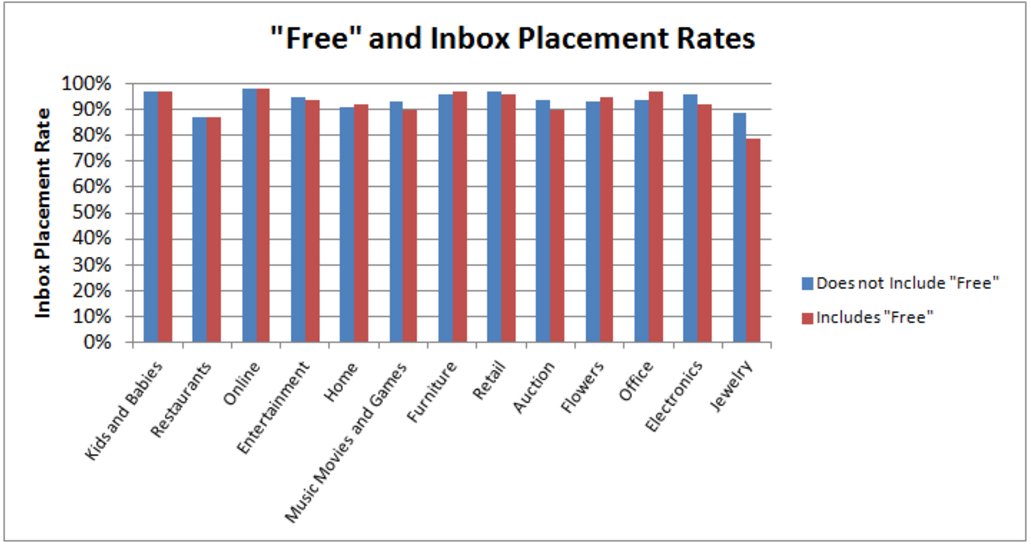The Words You Should Avoid In The Subject Line (Or Maybe Not)

At MailUp, one of the questions we encounter most often during seminars and workshops is: What are the words to avoid in the subject line so as not to be filtered into the junk mail folder? Are there infallible rules to avoid the spam label?

From developing integrations to strategic support, from creating creative concepts to optimizing results.
Email deliverability: a team game
The answer is more complex than one might expect. In fact, today the factors that affect the deliverability of a message go well beyond the chosen type of wording for the subject. It is definitely important to keep in mind a few golden rules, which we will analyse shortly, but we must always remember that the delivery rate is the result of a team game involving different elements.
Nowadays the big providers, which alone handle over 80% of total email traffic, don’t work on the basis of single words but rather on other reputation indicators of domains used or certain “fingerprints” of the message, the most important of which are as follows:
- Sender
- Subject
- Message Content
- Reputation of the sending domain
- Message frequency rate
- Sender’s presence in the address book
What does this mean in practice? It means that, in principle, one indicator alone is not sufficient to guarantee or prevent delivery of a message. An example: the leading anti-spam software, SpamAssassin, assigns a score to each item it perceives as risky (numbers are visible here, divided according to the part of the message they are usually found in): the message will risk ending up in the junk mail folder of the recipient when the sum of the scores exceeds a certain threshold (typically 5.0). One potential spam word in the subject line, therefore, can be harmless in the absence of other indicators on the danger threshold.
Concretely, some combinations that best explain the concept:
- A perfect subject line but a low reputation of the sending domain = high spam risk
- A message containing an image with only a few lines of text (Including legal and innocuous content) = high spam risk
- Sender added to the recipient’s address book = excellent rate of delivery, even if the other rules are violated

The importance of the subject line
Within the set of elements that go into determining the success of an email message, the subject still retains a position of prominence. In fact, this speaks to both humans and the computer system. With the former, it establishes an emotional/informational relationship: the quality of the subject largely determines the probability of whether the recipient will open the message or not. To the computer system, on the other hand, the subject gives indications on the credibility and quality of the message. This evidence complements the numerical data given by a relatively high opening rate, reverberating on the reputation of the sender and ultimately facilitating or hindering the delivery of the message to the recipient’s inbox.
In this post we analysed the best practices to be followed to create an effective subject line: length, customization, presence of dynamic fields, use of symbols, and more, both to entice the user to click and to optimize the delivery rate. This information should be taken as statistical guidelines: as we will never tire of repeating, the key to success for every business lies in testing, testing, testing. What works for others is not guaranteed to work for you. And vice-versa.
Words to avoid in the subject line
Given all these premises, it should now be clear that potential spam words should be known, but this should be integrated into a broader perspective of attention to deliverability criteria. These are the golden rules that are always worth following in the subject draft:
- Avoid writing in capitals
- Avoid exclamation points and minimize punctuation in general
- Avoid currency symbols and too many numbers
The literature warns against the use of terms such as:
- Offer indicators: free, offer, promotion, gift, loan, etc.
- Urgency indicators: limited time, hurry, etc.
- Calls to action related to orders/money: ask for a quote, buy now, order now, etc.
- Teasers: You won’t believe your eyes, The secret that nobody wants to reveal, etc.
But how valuable are these limitations nowadays? Not very, in both directions. Just as the inclusion of risky words doesn’t automatically condemn the mail to ending up in the junk folder, a subject composed according to the best guidelines is not sufficient to ensure delivery. To understand this mechanism, just take a look at the messages in Junk Folder of your email account. Are they really all full of uppercase and offers? Some subjects don’t correspond to the “spammer” profile we are used to: a sign that the provider can recognize, behind a seemingly innocuous subject, other potential spam signals.
The evidence does not end there. Some interesting studies show that in several sectors, subject lines containing high-risk spam items (such as the term free or whole words in upper case) present delivery rates substantially identical to emails with “clean” subjects. Proof that the rules apply until they are broken.


In short
Paying attention to the quality of the subject of the message is a key step to improving the delivery rate of the messages, but not the only one. The correct approach is “holistic” and doesn’t forget any of the factors used by the providers to determine whether the message is spam or not. MailUp offers you all the necessary tools to improve the delivery rate of your email campaigns and reach the inboxes of recipients:
- Certified IP addresses included in the most authoritative international whitelists
- Spam control system before sending each message, indicating the spam score and opportunity to correct the critical issues
- Specific advice on the topic with the program Delivery+